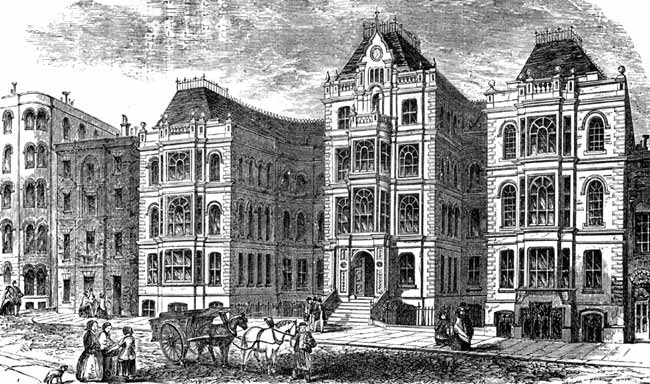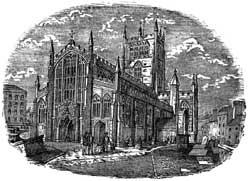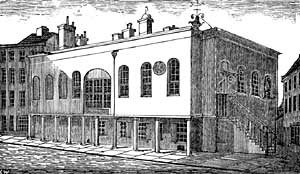At the foot of Broad-street — north — is Her Majesty's Prison, until recently designated the House of Correction. Its front is castellated in design. The prison covers about ten thousand square yards of land, and was formerly occupied as a hospital, dedicated to St. John the Baptist. Adjoining it is the Police Station, which will, with the Fire Brigade Station opposite, be shortly removed to South Sherwood-street.

WAREHOUSE OF THOMAS ADAMS AND CO., LIMITED, STONEY STREET.
Visitors should proceed up Heathcote-street the second street to the right from these two stations, and pass the People's Hall, with its reading room and small library, and enter Goose-gate. The left leads through Hockley, on to Sneinton Market-place and Baths, but visitors are not recommended to visit this locality unless they have ample time at their command, but are advised to cross Goose-gate, and enter Stoney-street. They will then find themselves in the midst of the Lace Market, of the importunce of which the large and imposing stone edifice, on the right, occupied by Messrs. Thomas Adams & Co., Limited, is no mean illustration. Other warehouses in the same street, and in Broadway, will testify to the progress which the town is making in wealth and importance.

ST. MARY'S CHURCH.
Reaching the end of the street ST. MARY's (the parish) CHURCH presents itself the most important, and, at the same time, the most imposing ecclesiastical edifice in the town. The Church stands on the north side of the High-pavement, and with its tower forms the most elevated and conspicuous object from every point of view. It contains several interesting monuments; a stone recumbent effigy in the south transept; curious carved groups of ecclesiastics in alabaster, let into the south chancel-wall; a valuable painting of the "Virgin and Child" by Fra Bartolomeo, the gift of Mr. Wright, of Upton; and a curiously-inscribed font. In the tower is a melodious peal of ten bells of great weight. Portions of Norman pillar capitals were found during the reparation of the present fabric, but the whole is now of the Perpendicular style. The plan of the church itself is cruciform, and the bole is of a comparatively late date. On entering the sacred edifice, spaciousness is the first idea suggested, and with reason, the length being 210 feet, and the width and height in proportion, nor can the lightness and elegance of its construction, and the number and size of its windows, with the small amount of masonry between them, fail to attract observation. The east window was filled with stained glass, by subscription, as a memorial of the late Prince Consort, and the large west window has been similarly decorated as a memorial to the late Mr. Thomas Adams; other windows in the chancel and transept are also filled with painted glass. The church has, from time to time, undergone considerable alterations and improvements, the latest being the erection of a chancel screen and reredos.
If time is pressing, or if the places hereafter mentioned are not interesting to them, visitors should wend their way to the Railway Station by "Hollow Stone"—the hilly road at the chancel end of the church. They will soon find themselves in Plumtre-square, where, on the left-hand side, is Plumtre's Hospital, one of the most ancient of Nottingham charities. The Hospital consists of thirteen dwellings. There are thirty out-pensioners of this charity, which was originally endowed in 1392. The present building occupies the site of an ancient one. Close by is St. Patrick's Roman Catholic Church, a plain brick and stone building, the altar of which covers a medieval bridge.

OLD GUILD HALL.
Leaving the church by way of the High-pavement, the County Hall appears on the left. This stone building was erected its 1773, and has been twice renovated and enlarged—in 1854 and since—and is used for holding the County and Town Assizes, quarter Sessions, &c. The prison at the back, on an almost perpendicular rock, 70 feet high, was closed by a recent Act of Parliament. On the right is the Judges' Lodgings, recently the temporary home of H.R.H. the Princess Louise, Marchioness of Lorne, and formerly the town residence of an opulent family named Fellows, of whom it was purchased by the county magistrates in 1832. Near to is a large and imposing Unitarian Chapel, a large spired stone building (the memorial stone of which was laid October 15, 1874), erected on the site of a former chapel. A little further on is an old-fashioned building, dignified by the name of the Guild, or Town Hall, of which an illustration is here given. It is used as a Police Court, and for Borough Quarter 'Sessions, but these Courts will be removed to the new building (see page 38) erected for the purpose during the present year (1888). There is little doubt that, ere long, this building will he numbered among the associations of the past. A woodcut of its predecessor will be found in Nottinghamshire Memorabilia, further on in this Guide. This is an old part of the town, and the market was held here for centuries. Opposite the old Guild Hall is "Weekday Cross," but no cross now remains.
[Visitors, however, who prefer the broader and most direct way to the Station, should proceed down the Low-pavement, previously noticed, to Lister-gate—two turns to the left—follow the tram lines, which, keeping to the left-hand, lead to the Stations. Proceeding down the narrow steep passage called Drury Hill, into Sussex-street, and the Broad and Narrow-marshes, strangers will immediately observe, that Nottingham, like all other large towns, has its upper and lower strata. A few yards further, across Canal-street, through Trent-street, and a foot-bridge leads to Station-street, in which are the Midland and Great Northern Stations. Here the sound of the engine whistle reminds visitors that their day's ramble is ended. We take our leave of them, hoping they have been pleased with what they have seen of Nottingham, and are satisfied with their chaperon.
On coming into the road—North Sherwood-street-visitors should walk to the top of it, and the Church Cemetery will be reached. This is thirteen acres in extent. Down the right-hand path there is a remarkable series of caverns, scooped out of the living rock. These caverns are exceedingly well adapted for catacombs and interments, and if the original plan be carried out, the Cemetery will, as a whole, perhaps stand unsurpassed in the kingdom. The tombs and monuments, which are numerous, present' most beautiful specimens of the sculptor's art. This Cemetery is well laid out, and is neatly kept. Viewing the north-west part of the country beyond the Cemetery, a diversity in the landscape is presented which the eye marvels at, and which the pen can but inadequately describe. In the centre are the populous manufacturing districts of Old Radford, Hyson Green, New Basford, and Carrington, now all absorbed into the Borough, whilst in the distance, to the left, is Wollaton Hall and Park, the former one of the most perfect specimens of English domestic architecture in the country. To the north may be descried a beautiful mansion, Bestwood Lodge, the seat of His Grace the Duke of St. Albans. As it were in a deep valley, is the picturesque Race-course and cricket Grounds, rendered more beautiful by a number of well arranged and profusely planted public walks. This race-course, lying in a valley, is one of the most prettily situated courses in the United Kingdom and spectators can see the whole of it, which is a mile and a quarter in circumference. Races are held here in spring and in autumn. The Grand Stand, near the centre, is not an elegant structure. The broad road skirting "the Forest" (as this locality is designated) is "the Gregory Boulevard," and is part of a belt round the commercial portion of the town.
A penny tram ride carries passengers nearly the length of Forest-road, starting from and to the Cemetery gates. This road runs along one side of the church Cemetery, and is a residential district. A little distance beyond the Cemetery, and on the same side of the road, is a brick structure of Gothic design—" the-Congregational Institute "—an Independent College for the training of about fifty students, who are non-resident. It was erected about 1867. On the left-hand side, partly hidden by a lofty stone wall, is the rear of "the High School" for boys.
Beyond the Race-course, and opposite the end of the Boulevard and the Police Station, is the Forest House; and just beyond, on the right-hand of the road, at the corner of Redcliffe-road, in Carrington, is an United Methodist Chapel, of neat design, and with a small tower and spire. A little distance beyond, opposite Mapperley Park and Hall, is the tram terminus, from which the journey to the Market-place may be made (fare 2d.)
Opposite the Cemetery gates is St. Andrew's Church—a striking landmark. Proceeding along the south side of this sacred edifice—Mapperley-road—past a number of superior residences, visitors will shortly arrive at St. Ann's Hill, or Belle Vue Reservoir, one of the principal water supplies for the town, where a panoramic view of marvellous extent is obtained, embracing much of the town of Nottingham, the valley of the Trent, with Belvoir Castle and Leicestershire Hills in the distance. It is approached by 'a flight of steps on the right hand of the road. On the opposite side of the reservoir (around which is a walk) are two avenues—the Corporation Oaks, and Elm Avenue.
Passing down the latter slope, visitors will emerge into Mansfield-road (a very broad highway, which is lined with trees—the first tree being planted December 9, 1863). Here they may meet with a passing tram-car going down the hill to the Market-place (fare 2d.) A short distance down the road, at the junction of live roads, on the right-hand side, is The Blue Coat School, designed in the Elizabethan style, standing in its own grounds, and opened in 1853. Sixty boys and twenty girls are educated here, by the funds bequeathed in 1706.
